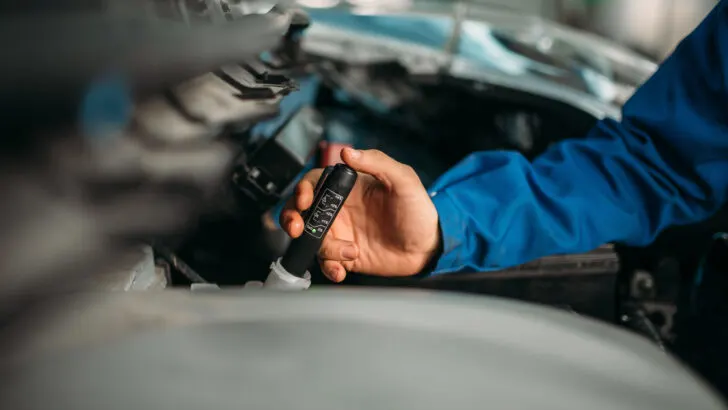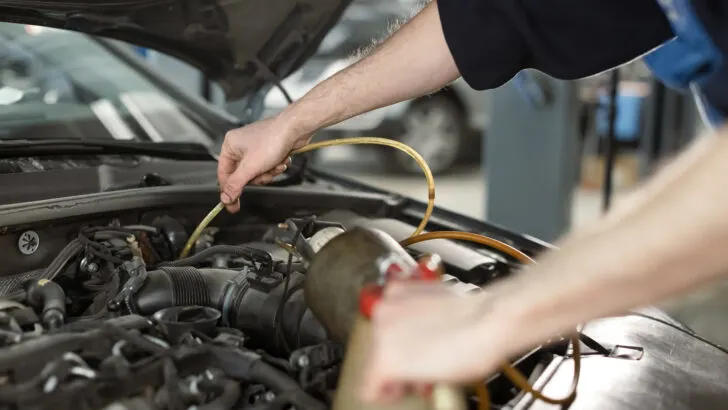Brake fluid is one of the many fluids that your car uses to ensure that it continues to run properly, but what does it mean if your brake fluid is green?
So, why is your brake fluid green?
If you find that your brake fluid is green, it means that your brake fluid is contaminated and should be changed before it does any damage to your car’s braking system. Not doing so could be an extreme safety hazard and potentially cause costly damage to your car.
As a car owner, there are a lot of fluids that you need to keep track of. Making sure that your car has enough of all of these fluids can be a daunting task. However, if you see that your brake fluid is green, that is a telltale sign that you need to get it changed.
But why is brake fluid so important in the first place, what causes it to turn green, and what can happen if you ignore the problem and continue driving your car? The answers to all of these questions can help you become a better car owner and avoid damaging your car unnecessarily.
What is Brake Fluid And Why Is It So Important?
Brake fluid is a hydraulic fluid that your car uses in its braking system and without it, your car simply would not be able to stop.
As you press down on the brake pedal, the force from your foot applies pressure to the brake fluid in your car’s braking system. Then, the brake fluid essentially multiplies the pressure you exert on the pedal which is then applied to your brakes in order to slow down and stop the vehicle.
Without brake fluid, your foot simply wouldn’t be able to produce nearly enough pressure for the brakes to stop a moving car, making it integral to your own safety, as well as the safety of others and the car itself.
How Often Should You Replace Your Brake Fluid?
Considering that brake fluid is so integral when it comes to your ability to stop your car, it’s important that you know how often it needs to be changed.
Most car manuals have varying recommendations when it comes to replacing brake fluid depending on the make and model of the particular car. If you want to be safe, you should check your car’s manual and follow whatever recommendation the automaker has.

However, if you are looking for a more general answer, it is good to make sure that your brake fluid is replaced every three years or 45,000 miles. Although, if you haven’t been keeping track up to this point, as long as you make sure the fluid is changed at least every few years, you should be ok.
Why Is My Brake Fluid Green?
Now that we know what exactly brake fluid is, what makes brake fluid turn green in the first place?
As you continue to use your brakes and the fluid is compressed over and over again, it can become contaminated with all sorts of metal particles that come off of the different components in the braking system.
As your brake fluid gets more and more contaminated with little pieces of metal, chemical reactions between the metal and your brake fluid can occur, usually causing the color of the fluid to change from clear or yellow to brown, green, or black.
The green color in particular comes from the oxidation of copper. As the copper particles are exposed to oxygen over time, the particle will oxidize, turning them green. However, how do these particles get in contact with so much oxygen if they’re submerged in brake fluid?
The reason these particles can oxidize is that brake fluid is hygroscopic, meaning that it absorbs moisture from the air. All this moisture that the fluid takes in contains oxygen which in turn causes the copper particles to oxidate.
However, this can only really happen if the particles are exposed to moisture or air for some reason. This is why getting your car checked every now and then to ensure that it has enough brake fluid and that there are no leaks that could cause oxygen contamination is incredibly important.
What Are Some Other Signs That You Need To Get More Brake Fluid?
If you notice that your brake fluid is green or otherwise discolored, that is a great first sign that you need to replace your car’s brake fluid, however, this isn’t the only sign your car will give you to tell you that the brake fluid needs to be replaced.
Noticing that your brake pedal feels a lot softer than usual is usually a good indication that you need to either replace or add more brake fluid. Essentially, if there isn’t enough brake fluid or it has gone bad, you will need to apply more pressure to the brake pedal if you want the vehicle to stop, meaning that you won’t be able to stop as quickly as you should be able to.

Another key signal is noticing an oily puddle under your car, especially located around the wheels. If your car is leaking brake fluid, there’s a good chance that you’ll need to get more and replace the remaining fluid immediately, if the leaking fluid hasn’t already completely gone bad.
One last sign that there could be a problem with your brake fluid is that the ABS warning light comes on. While this light could come on for a variety of reasons, having bad or not enough brake fluid could easily set it off too.
What Happens If You Continue To Drive With Bad Brake Fluid?
Continuing to drive your car with bad brake fluid comes with a variety of risks, both to the safety of yourself and others as well as financially.
As your brake fluid gets more and more contaminated over time, it gets less and less effective at stopping the car. This poses a serious safety risk to everyone both inside and outside of the car, not to mention the costly repairs that could come from a surprise accident.
Having bad or low brake fluid can also damage some of the other components of the braking system. Contaminated brake fluid with lots of little bits of oxidized metal on the inside doesn’t do a lot to help preserve the braking system. If you continue to drive with bad brake fluid, you’ll be increasingly likely to have to pay for additional costly repairs to your vehicle.
There’s no doubt that if you suspect that your brake fluid has gone bad or there simply isn’t enough of it, you should get your car into an auto repair shop immediately, in order to remedy the issue.
Key Takeaways to Brake Fluid Being Green
Brake fluid plays an incredibly important role in giving you the ability to stop your car.
If you notice that your brake fluid is green, it means that your brake fluid has gone bad and needs to be replaced.
The green color in particular is caused by the oxidation of copper particles in the brake fluid itself.
If your brake fluid has gone bad or there isn’t enough, you may notice your brake pedal feeling softer, in addition to puddles under your car and the ABS light turning on.
If you find that your brake fluid needs to be replaced you should go to an auto repair shop immediately.
